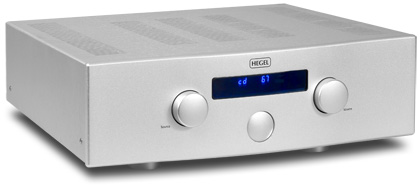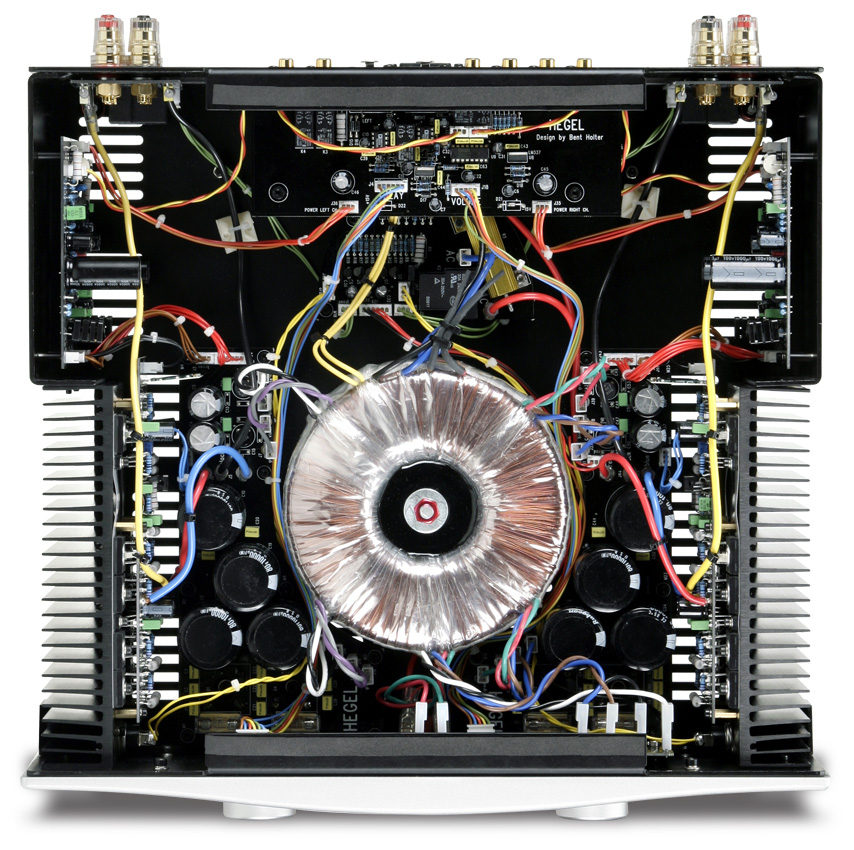 April 2010
Hegel Music Systems H200 Integrated
Amplifier

| Associated Equipment Speakers -- Wilson Audio Specialties Sophia
Integrated amplifier -- Jeff Rowland Design
Group Concentra
Digital sources -- Wadia 830 CD player,
Logitech Transporter, Apple MacBook laptop computer
Interconnects -- Cardas Audio Neutral
Reference
Speaker cables -- Cardas Audio Neutral
Reference
Headphones -- Sennheiser HD 600, Ultimate Ears
UE 11 Pro
Headphone amplifier -- Ray Samuels Audio
Emmeline "The Predator"
Accessories -- Audio Power Industries Power
Pack II, Cardas Audio Signature XLR, RCA and BNC caps |
|
|
|
Scandinavian countries, especially Denmark, have enjoyed a
long history rich in audio innovation and audio manufacturers, the latter including such
storied names as Dynaudio, Ortofon, Bang & Olufsen, and Electrocompaniet. Add to that
Hegel Music Systems, which, like Electrocompaniet, hails from Norway. New to the North
American market, Hegel produces digital source, DAC, and amplification components. The
H200 ($4400 USD), one of three Hegel models of integrated amplifier, combines in a single
chassis technology from Hegel’s H2A mk2 and H4A mk2 power amplifiers and P2A mk2
preamplifier.
Hegel’s underlying philosophy is to extract the best
sonic performance from the source by using off-the-shelf components and Hegel’s own
patented SoundEngine, which uses no global negative feedback and, Hegel claims, cancels
crossover distortion as the signal passes through all stages of the amplifier, purportedly
delivering all the benefits of class-A amplification in a class-A/B amplifier, with none
of the drawbacks associated with either type of design.
Specs and design
The Hegel H200 is a dual-mono class-A/B design with a
generous 200Wpc on tap into 8 ohms and a minimum load rating of 2 ohms. Clearly, the H200
should be able to drive most loudspeakers without a problem. The claimed frequency
response is 20Hz-20kHz, +/-0.2dB, the claimed distortion less than 0.01% at 100W.
At 17"W x 4.7"H x 15"D and 38 pounds, the
H200 is nice ’n’ tidy and easy to move around. Two colors are offered, silver
and black, but unless you really love black, go with silver -- the sleek, curved, matte
faceplate exudes modern, minimalist, Scandinavian design, but the black of my review
sample obscured those details. Central on the front panel is a blue LED display for source
and volume level, and below it is the Power button. To the right of the display is a large
Volume control, and to the left is a matching Source knob for selecting among CD,
Balanced, Auxiliary, and Home Theater (the last to switch in a separate A/V processor).
The rear panel has two pairs of five-way binding posts on
each side, and a centrally located IEC socket for the detachable AC cord. Along the top of
the rear panel are the inputs and outputs: in the center, a balanced XLR input, flanked by
two single-ended RCA inputs; to the right of these, a pair of RCA inputs for use with an
outboard A/V processor; and, to their left, two pairs of preamp outputs and one Record
Out, all RCAs. The top panel is brushed aluminum, with ventilation slots.
The H200 comes with a metal remote control with buttons for
Volume, Mute, and Source; it can also control a Hegel CD player. My only complaints are
that the remote’s buttons are very small, and that the absence of backlighting made
it difficult at first to use it in the dark. After a few weeks I knew where the buttons
were, and usually hit the right one.
Listening-room upgrade
Until now, my very first review for SoundStage!, in
November 2007, was the only one that had been the result of my experiences in a dedicated
listening room. Just before that review was published, my family and I moved into a
+40-year-old, 1800-square-foot tract house in which my listening room was a small spare
bedroom with less-than-optimal acoustics. The soundstage was narrow and shallow, and while
the reproduction of the treble and midrange were decent, the bass left a lot to be desired
-- the lowest octaves were less well defined than I’d have liked, though I was able
to fix this a bit with some well-placed furniture. I consoled myself that the arrangement
was temporary.
And it was. Last August we finally moved into our newly
built, 3120-square-foot house, where once again I have a dedicated listening room. At
17’L x 15’W x 13’H, with a cathedral ceiling, my new room’s volume is
larger than that of any other listening room I’ve had, and the results have been
impressive. The room’s width exceeds by 3’ that of the next widest room
I’ve had, and this means a broader, more diffuse soundstage that sounds more natural
than the tightly focused, hyper-realistic images I’d heard in my previous rooms.

Listening
After inserting the H200 in my system, I used it for
background music the first few days, mostly listening to my new boxed set of The
Beatles in Mono (CD, Capital 99451). The owner’s manual states that some break-in
time is necessary, and my first impression of the H200’s sound was that it was
tonally somewhat dark. However, after about a week’s worth of listening, the sound
opened up and the dark quality disappeared. Several weeks later, just before I went on
vacation, I powered down the H200. When I returned, so had that dark quality, but it
disappeared again after a few days. I conclude that, when not in use, the H200 should be
left powered up in Mute mode, and turned completely off only if the user doesn’t plan
to listen to it for an extended period.
Apart from that, the H200 performed well, and was at least
as transparent as the other integrated amps that have graced my rooms over the last two
years. The coin toss and Pete Townshend’s footsteps in "Music Must Change,"
from the Who’s Who Are You (CD, MCA MCAD-11492), was as vivid as I’ve
ever heard, with no obscuring of fine detail. The H200 also compared favorably with other
recently reviewed amps in being very quiet, producing stable images that emerged from a
black background with nice detail and focus. While the soundstage was wide, the depth
of that soundstage was even more impressive -- I could hear far into it, something
particularly noticeable with recordings of classical music. As I listened to Percy
Grainger’s The Warriors, performed by the Philharmonia Orchestra conducted by
John Eliot Gardiner (CD, Deutsche Grammophon 445 860-2), I could hear well into the deeper
recesses of the recording venue, London’s All Hallows Church, despite the fact that
this is a forward-sounding, room-filling recording.
If I had to describe the H200 in one word, that word would
be propulsive. Its ability to handle wide dynamic swings and sudden shifts in
rhythm meant that it was adept at handling uptempo music, especially rock and jazz fusion.
Bass lines were tight, nimble, and easy to follow, devoid of any sense of hesitancy. Kick
drums and tom toms had pounding, pulsating impact. On Chick Corea and John
McLaughlin’s Five Peace Band Live (CD, Concord CRE-31397-02), the rhythm
section has a powerful undercurrent that lays the foundation on which the jams are built.
As Christian McBride dug in deep with his bass and drummer Vinnie Colaiuta kept steady
time, the H200 had no difficulty in keeping the flow of this music going. Similarly, in
the middle break of the Who’s "The Real Me," from Quadrophenia (CD,
MCA MCD2-11463), as Roger Daltrey sings accompanied only by John Entwistle and Keith Moon,
the bass and drums maintain a forceful presence to complement Daltrey’s in-your-face
belting. The H200 definitely kept my toes a-tapping.
However, the H200 was no sledgehammer when it came to microdynamics,
and here is where Hegel’s proprietary SoundEngine probably had its biggest impact,
with refinement in the reproduction of the treble and midrange. The H200 displayed finesse
during quiet passages, and had a light touch with more delicate music, such as acoustic
guitar, solo piano, and gentle percussion. In "Ganges Delta Blues," from the Ry
Cooder and V.M. Bhatt’s A Meeting by the River (CD, Water Lily Acoustics
WLA-CS-29-CD), the lush interplay among Cooder’s bottleneck guitar, Bhatt’s
mohan vina, and Joachim Cooder’s tablas was meticulously reproduced, with every
subtle inflection laid bare. On "Flamenco Sketches," from Kind of Blue,
Miles Davis’ piercing, probing solo on muted trumpet is followed by John
Coltrane’s and Cannonball Adderley’s respective solos on tenor and alto sax, all
conveyed with natural, brassy warmth. And with all of their emotional intensity intact,
the solos themselves floated in a well-defined space, framed by the rhythm section playing
softly behind them.
Of all the amps I’ve reviewed over the past two years,
the H200 was probably the most difficult to compare with my Jeff Rowland Design Group
Concentra ($5600, now discontinued), because it was most similar. While two of those
review subjects, the Esoteric A-100 ($19,000) and the Luxman L-509u ($10,000), were
clearly better than the Concentra, and other amps equaled or exceeded the Rowland in
certain aspects, the H200 was so close in so many respects that, had this been a blind
test, I’d have had a difficult time telling them apart.
What finally allowed me to do so wasn’t a specific
sonic trait or signature, but what sort of music I found myself preferring. If I was
listening to something slow and graceful, such as a jazz piano trio, then I leaned in
favor of the Concentra, for its slightly richer midrange and airier treble. But when I
wanted something a bit more vigorous, such as rock or jazz fusion, then the H200 got the
nod, for its nimble bass. But regardless of the music, I could listen to either amp and
not miss the other -- that’s how similar they were.
Conclusion
The H200 may be new to North America, but Hegel Music
Systems has brought to the table a formidable competitor in terms of both performance and
price. Being able to perform as well as amps costing much more marks the H200 as a great
value -- and in these trying economic times, even more of one. Paired with a high-quality,
high-value digital source and speakers, the Hegel H200 could be the anchor of a killer
midpriced system. Hats off for a job well done.
. . . Uday Reddy
udayr@soundstagenetwork.com
Hegel Music Systems H200 Integrated Amplifier
Price: $4400 USD.
Warranty: Two years parts and labor.Hegel
Music Systems
P.O. Box 2, Torshov
NO-0412 Oslo, Norway
Phone: +47 22-60-56-60
Fax: +47 22-69-91-56
E-mail: info@hegel.com
Website: www.hegel.com
Hegel Music Systems USA
Fairfield, IA
Phone: (641) 209-3210
Fax: (641) 209-3076
E-mail: ben@hegel.com
Website: www.hegel.com |
|

